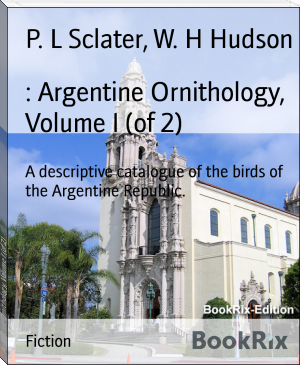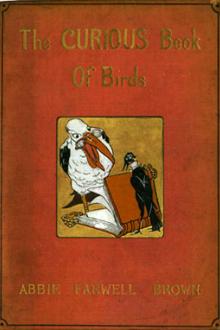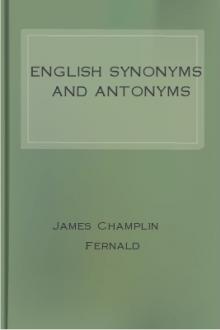: Argentine Ornithology, Volume I (of 2), P. L Sclater, W. H Hudson [best authors to read txt] 📗

- Author: P. L Sclater, W. H Hudson
Book online «: Argentine Ornithology, Volume I (of 2), P. L Sclater, W. H Hudson [best authors to read txt] 📗». Author P. L Sclater, W. H Hudson
+Cnipolegus cinereus+, _Scl. et Salv. Nomencl._ p. 43; _Döring,
Journ. f. Orn._ 1878, p. 197 (Cordova); _Salvin, Ibis_, 1880, p.
357, pl. x. (Tucuman, Salta).
_Description._--Dark cinereous, paler and more olivaceous on the
back and wings; edges of wing-coverts and secondaries rather
lighter; below paler, throat and breast blackish, like the head;
inner margins of wing-feathers whitish; outer primaries acuminated;
bill plumbeous, feet black: whole length 4·6 inches, wing 2·2,
tail 2·3. _Female_ brownish cinereous; cap and rump rufous; wings
blackish, tips of coverts and edges of outer secondaries whitish;
tail blackish, inner webs of all the lateral rectrices, except the
tips, rufous; beneath whitish.
_Hab._ Northern Argentina.
131. LICHENOPS PERSPICILLATUS (Gm.). (SILVER-BILL TYRANT.)+Lichenops perspicillatus+, _Burm. La-Plata Reise_, ii. p. 457 (La
Plata to Mendoza); _Scl. et Salv. P. Z. S._ 1868, p. 141 (Buenos
Ayres); _iid. Nomencl._ p. 43; _Hudson, P. Z. S._ 1869, p. 432
(Buenos Ayres); _Gibson, Ibis_, 1880, p. 21 (Buenos Ayres);
_White, P. Z. S._ 1882, p. 604 (Buenos Ayres); _Barrows, Bull.
Nutt. Orn. Cl._ vol. viii. p. 141 (Entrerios, Azul).
_Description._--Uniform black; primaries pure white, with black tips
and bases; fleshy ring around the eye and bill yellow, feet black:
whole length 5·6 inches, wings 3·5, tail 2·4. _Female_ above dark
brown, with light brown edgings to the feathers; remiges chestnut,
with dark-brown tips; wing-coverts dark brown with fulvous
tips; beneath fulvous white, breast with dark striations; under
wing-coverts fulvous; bill yellowish, feet black.
_Hab._ Southern Bolivia, S.E. Brazil, Paraguay, Uruguay, La Plata,
Chili, and Patagonia.
Naturalists have said a great deal about the well-known Silver-bill (the
most important member of my "_Spectacular_" group), the question as to
whether the black and red birds are sexes or two distinct species having
long remained unsettled. Azara, writing in the last century, under the
heading _Pico de Plata_, rightly described the red bird as the female of
the black; but, unfortunately, in another part of his work he described
the female again as a different species, naming it _Suiriri chorreado_.
Darwin also separated the sexes, and gave the name of _Lichenops
erythropterus_ to the red-plumaged bird. The following extract gives
only a portion of his argument, and is interesting to read, even now,
when the question has been finally set at rest, as it shows how much
the two birds differ:--"The tail of _L. erythropterus_ is squarer and
contains only ten feathers instead of twelve: the wing is 4/10 of an
inch shorter; and the secondaries relative to the primaries are also
shorter. The red colour on the primaries represents but does not
correspond with the white on the black feathers of _L. perspicillatus_;
and the secondaries in the two birds are quite differently marked.
In _L. erythropterus_ the third, fourth, and fifth primaries are the
longest, and are equal to each other; the second is only a little
shorter than the third. In _L. perspicillatus_ the third is rather
shorter than the fourth and fifth; and the second is proportionately
shorter relative to the third, so that the outer part of the wing in
this species is more pointed than in _L. erythropterus_. The outer
claw in the latter species is only in a small degree straighter than
in the former; and this, considering that _L. perspicillatus_ is
generally perched, and when on the ground can only hop, and that _L.
erythropterus_ feeds there entirely, and walks, is very remarkable."
When one considers the habits of the two birds, even where they are most
abundant and seen continually, it is indeed difficult to believe that
they are of the same species. They are never seen associating together,
even in the love-season, and when I have watched a pair actually engaged
in constructing their nest, they appeared to keep as far apart as
possible. More than that, the male, while unfriendly towards all other
species, appears to cherish a special antipathy against the red bird;
and when one comes near him never fails to pursue it with the greatest
virulence from the neighbourhood. He is also strictly solitary, but the
red birds frequently unite in small parties, especially in autumn, when
I have often seen as many as a dozen together.
Altogether the Silver-bill has been a puzzle in the past, and it would
now appear, from some recent observations made by Mr. Barrows, that we
have not yet got to the end of all the curious points in its habits.
Without doubt it is migratory. Its range extends from Paraguay to
Patagonia, where it is not common. In Paraguay and the hotter parts of
the Argentine country it is probably stationary; in Buenos Ayres, where
it is most abundant, many individuals remain all the year in sheltered
places, and the migration appears to become more definite the further
south we get. Mr. Barrows travelled south across the pampas in the
autumn, and says:--"The species was met with at all points visited,
but south of the Azul not a single male in the black plumage was seen,
though the brown birds (presumably females or young) were met with
almost every day for nine weeks, and frequently in large numbers. Of
course I began to suspect that the males must moult into a brown suit
after nesting, as do our Bobolinks and many other birds, but I shot
specimens at various times, and all proved to be either females or young
males, and as I was confident that at Concepcion black males were to be
found through the year, I was at a loss for an explanation, and am so
still."
The male Silver-bill is entirely black, there is nothing in nature
blacker than its plumage; and, to enhance the effect, the beak is of a
very delicate primrose-yellow, which at a little distance appears white,
hence the vernacular name. The eye, and broad free skin surrounding
it, which is ruffed like an Elizabethan collar, are of the same faint
primrose hue. The secondary wing-quills are pure white, but the white
is only displayed when the bird flies. The female has the naked skin
encircling the eye, but its colour, as also that of the beak, is much
darker than in the male. Entire upper plumage dark brown; secondaries
chestnut; lower parts fawn-colour, marked with brown. The young males
are at first like the females in colour, and do not acquire the black
plumage until the end of the summer.
The bird ranges over the whole of the Argentine Republic, and, according
to Gay, is also common throughout Chili, where it is known as the
_Colegial_ (Collegian or learned person), on account of its stiff grave
manner, black dress, and spectacled appearance.
The male is a solitary bird, and feeds chiefly on the ground, running
rapidly about in open places like a _Muscisaxicola_. It is also
frequently seen perched conspicuously on the summit of a tall stalk or
bush, and occasionally making a dart into the air after passing insects,
showing in this habit his relationship with the Tyrant-birds. But he
perches on an elevation less to watch for insects than for the purpose
of his curious spectacular performance. This highly eccentric habit is
strikingly like that of _Cnipolegus hudsoni_; and I have no doubt that
all the _Cnipolegi_ possess similar habits. Both birds perch on a
conspicuous place, upright, motionless, and looking more like grotesque
little automata than living things; they both also leave the perch
suddenly, as if shot from it by means of a steel spring. This singularly
sudden movement, and the motion of the wings, rapid as in the
Humming-bird, or shut and opened alternately and exhibiting the white
wing-colour in a series of flashes, seems related to the conspicuous
white mark. In both species, also, the wings make a humming sound during
flight. The motions of the Silver-bill are, however, in some respects
different from those of the _Cnipolegus_. Springing from its perch at
intervals, it darts vertically to a height of about fifteen yards, then
turns a summersault, uttering at the same moment a shrill-sounding
little cry, after which it drops down again and alights on its perch
suddenly, as if jerked back to it, and there remains stiff, erect, and
motionless as before.
The nest is made of dry grass in a thistle-bush or clump of reeds, and
is rather deep and cup-shaped. The eggs are four in number, white, and
spotted at the larger end with dark red.
132. MACHETORNIS RIXOSA (Vieill.). (SHORT-WINGED TYRANT.)
+Machetornis rixosa+, _Burm. La-Plata Reise_, ii. p. 458 (Paraná);
_Scl. et Salv. P. Z. S._ 1868, p. 142; _iid. Nomencl._ p. 44;
_Hudson, P. Z. S._ 1874, p. 173 (Buenos Ayres); _Durnford, Ibis_,
1877, p. 177 (Buenos Ayres); _Salvin, Ibis_, 1880, p. 357
(Salta); _Barrows, Bull. Nutt. Orn. Cl._ viii. p. 142
(Entrerios).
_Description._--Above brownish olive; wings and tail brown, the
latter terminated by a yellowish band; middle of cap occupied by a
scarlet crest; beneath bright yellow, paler on the throat; bill and
feet black: whole length 7·2 inches, wing 3·9, tail 3·5. _Female_
similar, but rather duller. Young without the scarlet crest.
_Hab._ S.E. Brazil, Bolivia, Paraguay, Uruguay, and La Plata.
This species, found in the open districts throughout South America,
from Venezuela to Buenos Ayres, where it is quite common, has very
interesting habits. It is seven inches and a half long, has a plump
body, short wings, and long legs. The upper plumage is light brown, the
throat, breast, and belly yellow, and the male has a concealed crest of
a bright orange-red colour.
It resembles the true Tyrants in disposition, in its shrill piercing
language, and in the habit of perching and breeding in trees. On the
other hand, like the long-legged _Myiotheretes_, that lives on the open
plains, it feeds exclusively on the ground, over which it runs with a
speed possessed by few perching species. The general impression one
forms is that in manners and appearance the Short-winged Tyrant is quite
unlike any other species, though all its habits are to be found in one
or other of the various groups comprising the _Tyrannidæ_.
These birds have no migration, but pair for life, and always remain on
the same spot, and will continue to breed in the same hole for many
years, even where they are frequently deprived of their eggs. Azara saw
them sometimes uniting in small flocks in Paraguay; in Buenos Ayres they
are always seen in pairs, or, after the young have left the nest, in
families. They prefer to live near a human habitation, where there are
trees: even one tree, in which they can breed and find shelter at night,
will be sufficient to attach them to a dwelling, so great is their
partiality for the clean-trodden ground where they can freely run about
and catch insects. They haunt the cattle-pens, and become extremely
familiar with the cows, horses, and sheep, following them to the
pasture-grounds, where they are often seen perched on the back of a
horse





Comments (0)